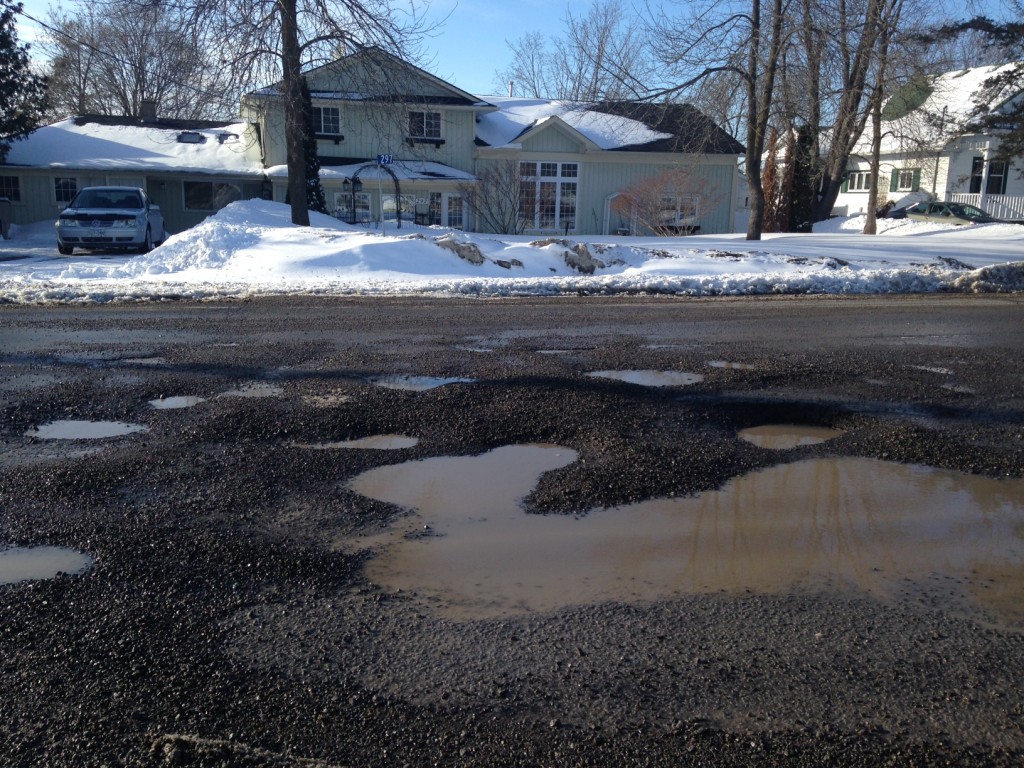 [1]
[1]CANNIFTON – As temperatures rise above 0C, potholes are emerging and becoming a big problem. These potholes are north of Belleville at the corner of Tank Farm Road and Cannifton Road in Cannifton. Photo by Greg Murphy
By Greg Murphy [2]
BELLEVILLE – A Police Foundations student at Loyalist College [3] says he’s “in deep” in car repairs because of a pothole he hit while getting to school.
Two months ago, first-year student Jared Farrow said, he blew his front tires and broke his windshield while travelling down Sidney Street after hitting a pothole.
“A chip that I had in my windshield decided to crack all the way across, making vision terrible. I also damaged my tires. I had pretty good winter tires but now they are flat,” he said.
Farrow took his car to a mechanic for a damage assessment. He was told that the repairs would set him back almost $600 – an amount he can’t afford. Farrow is still driving the car, but he says he can’t fix it until the summer, when he can work full-time.
Though he is concerned about repairing his vehicle, he is mostly worried about safety while driving around potholes.
“People swerve around them all the time. Oncoming traffic can get hit. It’s just not safe,” said Farrow.
He, among other students QNet News spoke with around the college, said he thinks the city is not patching potholes quickly enough.
“Every day I come to school there’s more. Especially coming off the highway onto Wallbridge-Loyalist Road there’s tons of them,” he said.
Over at city hall, the pothole concerns aren’t being taken lightly.
On its Facebook page Jan. 6 [4], the city issued a warning about potholes and invited residents to report where they were. Citizens flocked to share where they had seen or run over potholes. In the comments section, the city posted that citizens can submit a damage claim through the clerk’s office to receive compensation. City clerk Matt MacDonald [5] said he’s seen a significant increase in these claims this year.
Toward the end of this past February, MacDonald said, the city was “about three times higher in claims … than we would have seen on the same date in 2013.”
Once a claimant fills out the form, the city gives it to its insurer, which then assigns an adjuster to handle the claim. The claim is successful if the adjuster determines that the city’s public-works department has not met the minimum maintenance standard of roadway repair at the location where the claimant sustained vehicle damage.
“The minimum maintenance standard spells out the patrols, identification of hazards, potholes, what have you, and then the maintenance schedule of that,” said MacDonald.
Sometimes a claim can be denied.
“If the city is meeting the minimum maintenance standard, then typically the municipality, through the insurer, doesn’t claim there was negligence causing the damage or that the city is responsible,” MacDonald said.
Over at the public-works yard, the transportation department has had its hands full keeping up with patching potholes. City transportation manager Pat McNulty [6] said he has four road-repair crews out every day filling them.
“We’re doing our best – like I say, I’ve got four crews out right now. When the weather goes up and down, below zero and above zero – that helps create potholes. We’re doing our best to keep up but I think we’re doing a great job,” said McNulty.
When water freezes at night under the road, it expands into pockets, pushing the asphalt up. As temperatures rise above zero, when the ice melts, the pockets are left with just water for support underneath the surface. Potholes are created when vehicles drive over these pockets continuously until the asphalt breaks up.
Right now, potholes are being filled with a temporary cold asphalt mix. McNulty said road-maintenance crews have to wait until the weather warms up before they can lay down a more permanent hot-asphalt mix, since that process requires warm weather to keep it hot and dry until the asphalt hardens.
Related:
Slick sidewalks are hurting businesses, some Belleville store owners say [7]
Local politicians concerned with highway maintenance, snow removal [8]